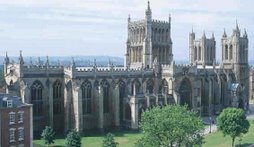Did you celebrate "Anglican Communion Sunday" with us two weeks ago at St. Mark's? If so, then you received a foretaste of the feast to come, so to speak, as we celebrated the Communion liturgy and music nearly IDENTICALLY to the service here in Bristol. We borrowed the language of the contemporary Anglican Prayer Book and sang the same setting of the service music, in this case by British composer Harold Darke (click HERE for more info on him).
Completely unknown to us was this AWESOME bit of "it's a small world" - the composer of our chosen communion anthem "If Ye Love Me", Philip Wilby, is the HUSBAND of the Rev. Wendy Wilby, the CANON PRECENTOR of Bristol Cathedral, who has been the cantor for most of our Evensong services!! It's one of Ed Rieke's favorite pieces, and he chose it completely unaware of the connection - isn't that amazing?! Here they are with Ed, Grace and Kristin.

We got to meet Philip earlier this week when he attended the Evensong on Friday night. Last night he had a piece for organ and brass premiered in the Royal Albert Hall at the Proms Concerts - his music is a big deal!
Here we are lined up in the Chapter House awaiting the start of the service. This part of the cathedral is where the monks used to gather - it dates from 1180!

It was wonderful to have Rev. Mike Chalk participating in this morning's service as well. He joined the processional and was the priest who served all of us communion. It was very moving for us.
After a short lunch break we were back at the cathedral for our final service of this residency. It's gone by so quickly... it hardly seems possible that the week is over.... (Can you keep a secret?? We've already convinced Ed to plan the next one! We hope YOU'LL join us next time!)
Our final service at Bristol Cathedral.
Preces/Responses: Hancock
Psalm 88:1-10
Service: Dyson in D Major
Anthem: Hancock You Are One in Christ Jesus
Sir George Dyson (1883–1964) was a well-known English musician and composer. His son is the physicist Freeman Dyson and his grandchildren are Freeman's children the science historian George Dyson and his sister Esther Dyson. He attended the Royal College of Music (where he studied under Stanford) and then worked for thirty years as a school music teacher (at Rugby, Wellington and Winchester), before being appointed as Director of the Royal College of Music in 1937. He received a knighthood in 1941 and was made a Knight Commander of the Royal Victorian Order (KCVO) in 1953.
Dyson composed some fifty works for the Anglican liturgy, including two complete morning and evening Canticles in D major and F major, as well as a setting of the evening service in C minor for trebles. The two evening services for full choir remain extremely popular in English churches and cathedrals, and are certainly part of the core repertoire. In the Oxford Companion to Music, Percy Scholes described his compositions as "skillful, sometimes deeply felt, but never forward-looking in idiom".
Gerre Hancock’s anthem, You Are One in Christ Jesus, was commissioned by the members of St. Mark’s Episcopal Church to honor and commemorate 25 years of service by their Organist and Director of Music, Edwin Rieke. The anthem opens with quietly intense “alleluias” growing out of the organ motive. The text (Galatians 3:27-28) is supported by an undulating organ accompaniment which grows in color and volume to return to the “alleluias.” In the final section, the entire text is chanted on a single note while the organ plays the hymn tune, McKee, “In Christ There Is No East or West.”
Following the Evensong service, Philip and Wendy Wilby hosted a lovely wine and cheese reception for all of us in the Chapter House. Both Philip and Wendy are such lovely people. In fact, all of the cathedral staff has just been fabulous to us, so warm and welcoming and helpful with this detail and with that question. And they've been very appreciative of our singing also.

Some of our group are going their separate ways tonight, either back to the States or on to various other vacation destinations. Most of us, however, will board the bus for London tomorrow for three more days of sightseeing. Keep checking in for more pictures and news!























